Editor & Publisher looks at the list of solutions being proposed to the newspaper industry’s troubles and adds a new one into the mix: the Low-Profit Limited Liability Company, or L3C. An L3C “is a corporation that qualifies as a charity under IRS rules but runs as a for-profit business,” Mark Fitzgerald explains, and it’s gathering momentum as a rescue strategy among various chapters of the Newspaper Guild.
That’s right: The Newspaper Guild may get into the business of running newspapers, if only to save its membership from annihilation. An L3C is allowed to take investments from charities and nonprofits because it has a “social benefit.” This new kind of nonprofit is now permitted in several states and the Guild “is lobbying for federal legislation – expected to be introduced later this spring – that would explicitly include newspapers among businesses that have a ‘social benefit.'”
Apparently, the thinking is that a lot of newspapers are going to come on the market selling at pennies on the dollar this year and this new tax structure would allow owners to spread out ownership among a great many entities, including businesses like printing press makers and auto dealers who have a vested interest in maintaining the business. Foundations would also be able to treat their donations as investments that could earn a return.
Another school of thought is to tear down antitrust rules that prevent newspapers from cooperating on fixing prices, E&P says. This could be a solution to the “content wants to be free” problem: If newspaper owners can legally collude to set prices and licensing fees for their content, then they can conceivably reverse the tide and charge for their product.
One thread is clear throughout the feature, though: No one is seriously arguing that newspapers should be publicly supported like National Public Radio. The consensus among owners and even Guild officials is that these businesses must stand on their own.
BTW, this story was just put online on April 1 after first appearing in E&P‘s print edition in March.
Sun-Times Parent is Bankrupt
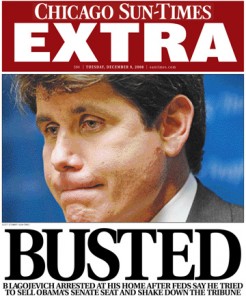 Sun-Times Media Group, Inc. (STMG), which operates 59 newspapers and websites, including the Chicago Sun-Times, filed for bankruptcy on Tuesday. The company has been under severe financial and competitive pressure and was weakened by a fraud scandal that landed two previous executives in jail. Chairman and interim CEO Jeremy Halbreich said the company is looking at possible asset sales and new investments, and that it has sufficient resources to work through the bankruptcy process.
Sun-Times Media Group, Inc. (STMG), which operates 59 newspapers and websites, including the Chicago Sun-Times, filed for bankruptcy on Tuesday. The company has been under severe financial and competitive pressure and was weakened by a fraud scandal that landed two previous executives in jail. Chairman and interim CEO Jeremy Halbreich said the company is looking at possible asset sales and new investments, and that it has sufficient resources to work through the bankruptcy process.
The Toronto Globe and Mail looks deeper into STMG’s financial situation and the ripple effect of the 2007 fraud convictions. Last year, the company lost $344-million on revenue of $324-million, as advertising revenue fell 18 per cent in the fourth quarter and is expected to drop 30 per cent in 2009. What’s more, STMG is contractually obligated to pay the former executives’ legal costs, which total $118 million so far. To top it all off, it may face a $510 million tax obligation as a consequence of illegal deductions those executives took.
Dour Pew Report Nevertheless Offers Hope
 “This is the sixth edition of our annual report on the State of the News Media in the United States. It is also the bleakest,” reads the introduction to The Project for Excellence in Journalism’s annual State of the News Media report. It certainly delivers on that promise. We haven’t read all 180,000 words, nor are we likely to, but you can start with the executive summary if you want to dive in yourself.
“This is the sixth edition of our annual report on the State of the News Media in the United States. It is also the bleakest,” reads the introduction to The Project for Excellence in Journalism’s annual State of the News Media report. It certainly delivers on that promise. We haven’t read all 180,000 words, nor are we likely to, but you can start with the executive summary if you want to dive in yourself.
The media overall had a terrible year in 2008 with the newspaper and magazine segments being hit the hardest and the cable TV industry providing the single bright spot. Cable networks actually increased their newsroom investments by an average of 7% during the year, with CNN adding bureaus in 10 cities. This modest growth wasn’t nearly enough to make up for the huge cost cuts in other media, though. By the end of 2008, all three TV networks had pulled their embedded reporters from Iraq. Newspaper circulations continued to decline; Sunday readership is off 17% since 2001.
The biggest disaster was in news magazines, with only one in four Americans reporting they’ve read one the day before. Time, which invented the genre, may be the only one left pretty soon, the report says.
Public trust in media dropped, but historical data shows that this trend is erratic. Interestingly, a vast majority of Americans (70%) believe the media favored Barack Obama in the most recent election. Even a majority of Democrats believe that.
Newspapers are in “free fall,” the report concludes, although “We still do not subscribe to the theory that the death of the industry is imminent. The industry over all in 2008 remained profitable,” turned in revenues of $38 billion and employed 45,000 professionals gathering and editing the news. There is reason to believe that traditional walls between online and print are falling and that newspapers are figuring out how to monetize targeted audience segments. They also appear to be much more open to working with aggregators and partners.
Still, the long-term outlook continues to be dim because of the economy, debt pressure and the unwillingness of investors to spend money in mature markets. The value that papers provide, though, is only increasing in importance. “In what traditionalists tend to dismiss as a cacophony of talking heads, celebrity infotainment, opinion-driven blogosphere exchanges and information overload, the integrity and sense-making of professionally done news should be more valuable than ever.”
The report also has an interesting section analyzing the practices and credibility of citizen media. It features an update of an earlier report that audited 64 citizen news sites. The new research should provide some comfort to established news organizations because it finds that, in general, they do a better job of incorporating citizen voices into their coverage than pure grassroots citizen operations. In particular, legacy news organizations are better at giving citizens a voice in published content and making it easy for readers to download and share information. In fact, the only area in which mainstream media’s citizen journalism ventures failed to outshine the grassroots sites was in linking to competitors’ content.
Finally, the report includes profiles of several new media ventures, ranging from NewHavenIndependent.org to MinnPost.com to GlobalPost.com.
Miscellany
The San Francisco Chronicle‘s buyout offer has 120 takers, which is more than was expected. As a result, the involuntary layoff total won’t be as high as many had feared. The newspaper management has been working with the union to restructure its contract. Even with the buyout, remaining employees will still see pay cuts and longer hours.
The Livingston County (Mich.) Daily Press & Argus has announced a “significant but unspecified number of layoffs” in its 95-employee workforce. Management would only say that the number was more than 10 and included Managing Editor Maria Stuart.
The Staunton (Va.) Daily News Leader will cut eight full-time employees and 15 part-timers from a workforce of unspecified size. Just one day earlier, the paper said it would outsource its printing operations to the Harrisonburg Daily News-Record. Laid-off employees include “press operators, mailroom workers and other employees charged with the production side of printing the paper every day.”
If you’re in Eugene, Oregon this afternoon, you can stop by the university at 4 p.m. and hear Boston Globe editor Martin Baron talk about the challenges facing newspapers, presumably including his own. The Globe laid off another 50 people last week.
 Amid all the hand-wringing about the lack of new-media alternatives to newspapers, the online-only
Amid all the hand-wringing about the lack of new-media alternatives to newspapers, the online-only  John Yemma would probably agree. As his publication, the Christian Science Monitor, goes Web-mostly, the editor (right) has launched a blog that he hopes will be “a place to talk about the changes in media.” In his second entry,
John Yemma would probably agree. As his publication, the Christian Science Monitor, goes Web-mostly, the editor (right) has launched a blog that he hopes will be “a place to talk about the changes in media.” In his second entry, 
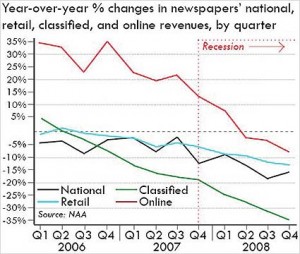

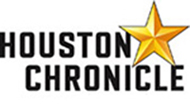 The Houston Chronicle joins the long string of newspapers that assert their commitment to “strong watchdog journalism” while covering news of their own troubles with e.e. cummings-like simplicity. The newspaper devotes just 208 words to news that it is laying off 12% of its staff, or nearly 200 people. That’s about one word per victim. In fact, the Chronicle doesn’t even mention a body count. You have to
The Houston Chronicle joins the long string of newspapers that assert their commitment to “strong watchdog journalism” while covering news of their own troubles with e.e. cummings-like simplicity. The newspaper devotes just 208 words to news that it is laying off 12% of its staff, or nearly 200 people. That’s about one word per victim. In fact, the Chronicle doesn’t even mention a body count. You have to 
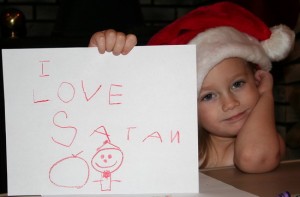
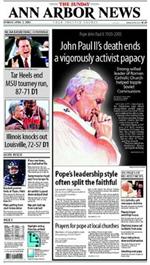
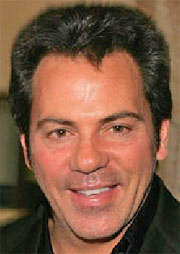

 Today is Newspaper Death Watch’s second birthday (you can
Today is Newspaper Death Watch’s second birthday (you can 





